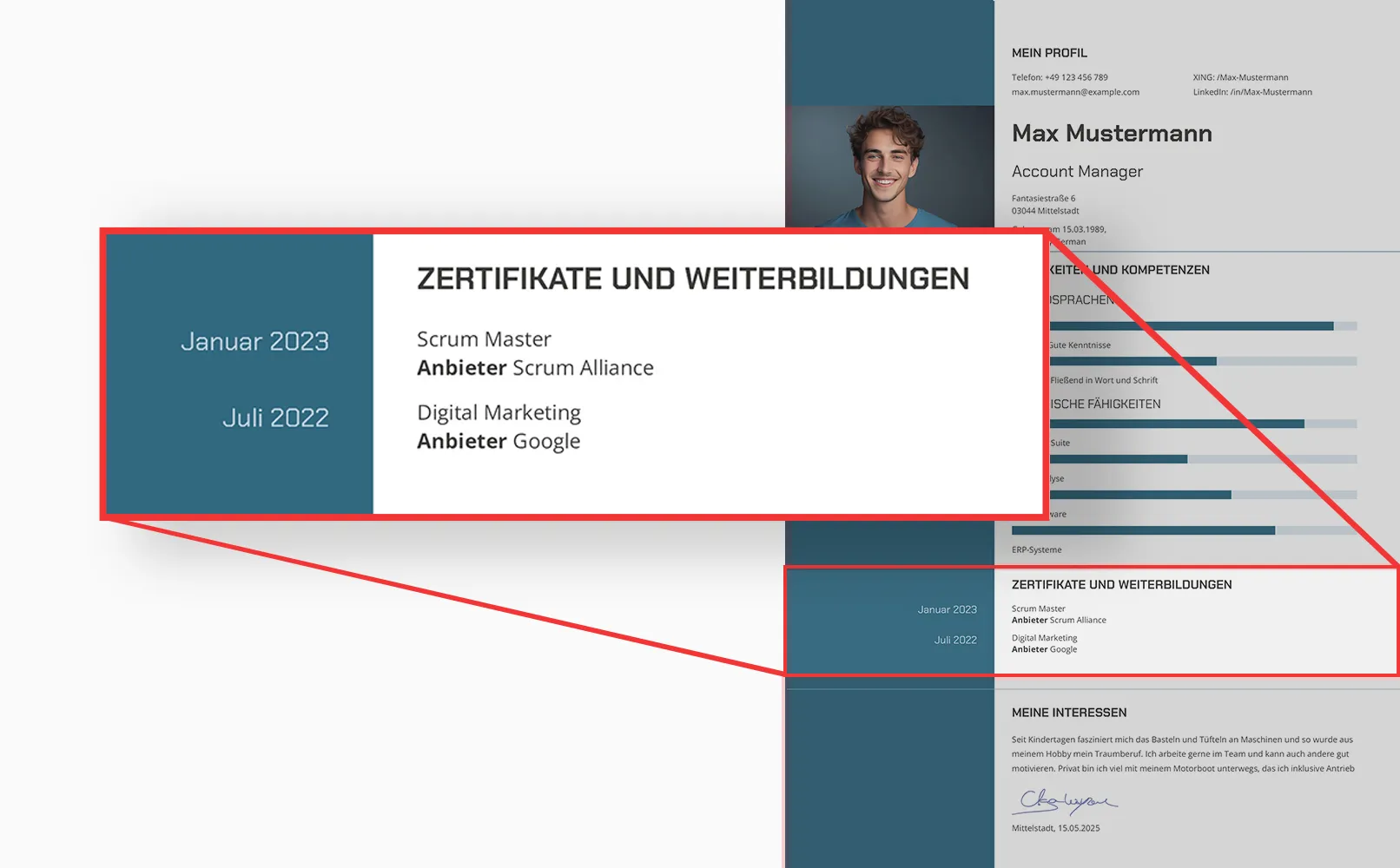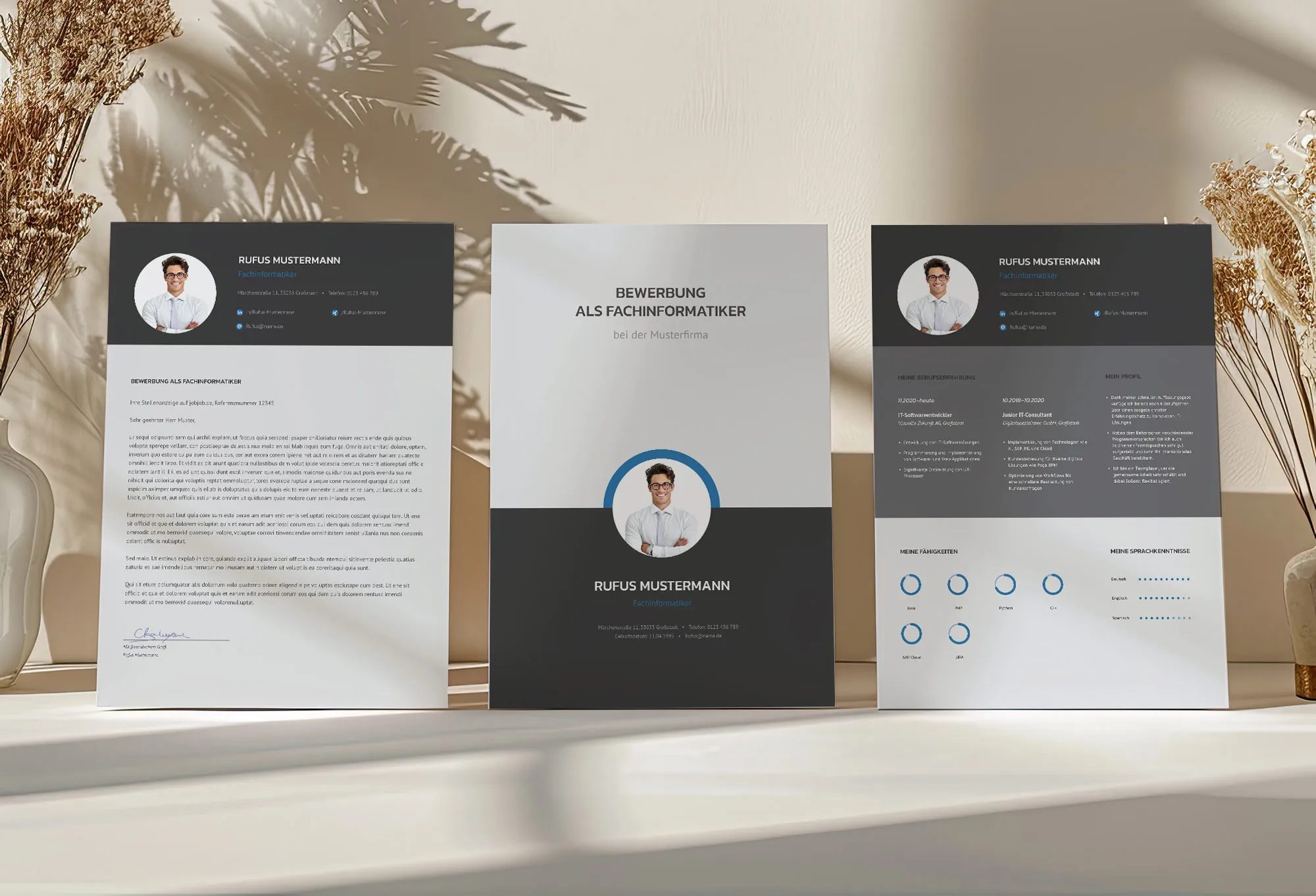Further education in your resume: Emphasize your development
Do you want your resume to stand out from the crowd? Then don't ignore the section Further Education. It is not just a formality, but proof of your willingness for continuous professional development. Employers are always looking for individuals who are constantly learning and striving to improve. If you don't list your additional courses and training, you miss the chance to demonstrate that you are keeping up with the times and are ready for new challenges.

This article shows you how to fill out the section Further Education so that it becomes your asset in job hunting. Forget general phrases and standardized approaches - it's time to show that you are a real professional who invests in their future. Ready to take your resume to the next level? Then keep reading!
An investment in knowledge pays the best interest.
Benjamin Franklin
This article is just a part of our series on the Structure of the Resume. We have many more articles that can help you perfect your resume. Check out the other articles to learn more about topics such as work experience, education, and special skills. Click on the link and discover all the helpful posts.
The Significance of the Further Education Section for the Resume
The Further Education section in the resume should serve as an indicator of your professional activity. It demonstrates your ability and willingness to continuously improve your skills. If you do not evolve, you remain stagnant, which is not acceptable in the modern job market. Fill out this section correctly to show that you are eager to learn and adaptable.

You should demonstrate that you fulfill your duties and are also informed about the latest trends and technologies in your field. The "Further Education" section should clarify to the employer that you keep pace with changes and actively adapt. If you do not specify your additional courses and training, the employer might think that your knowledge for the position is outdated.
Remember, your efforts towards development are your competitive advantage. By investing in your education, you show that you are willing to excel beyond other candidates. The employer will recognize that you aspire to achieve high goals in the new job and be valuable to the company. This gives you a significant advantage in their eyes. By including current and relevant courses in your resume, you underline this professional development. Therefore, show that you are ready to learn and grow beyond basic skills. Prove that you belong to the kind of employees who are constantly improving and aiming for more.
📄 Let us help you in your job search - go to the section Resume Templates and download your template now!
Why It's Worth Filling Out This Section
This section reflects your efforts to continuously learn and improve your qualifications. You are not standing still, but actively developing your skills to stay at the forefront of your industry. Employers value employees who continually evolve, and this is your opportunity to show that you are one of them.
A well-filled Further Education section shows the HR manager that you are actively working on enhancing your professional skills to meet the demands of the modern job market. If you do not provide this information, it may be assumed that you are not ready for new challenges and changes. Show that you know what the market demands and that you are prepared to adapt and bring new ideas to the company.
It is better to learn late than never.
Publilius Syrus
A completed Further Education section demonstrates your motivation and willingness to invest in your professional development. It also confirms your motivation to stay up to date on topics relevant to the job. Motivation is something employers seek in candidates, and this section can be your advantage. Motivation is rarely triggered externally by incentives. When someone proves they have a high level of self-motivation, they are the perfect candidate.
Therefore, take the opportunity to demonstrate that you are a serious candidate who is ready to constantly develop and improve. Fill out this section and make sure your resume stands out from others.

Which information should be included in the Education section of the CV
Do not fill out the education data randomly. Every detail counts. You should include the following in this section:
- Names of the courses and programs: Provide the exact names of the courses, training, and seminars. No abstractions. For example, instead of "Programming course," write "Python for Data Science."
- Names of educational institutions: Mention the specific names of the institutions where you completed the education. This gives more weight to your information. "Marketing course from Google" sounds much better than just "Marketing course."
- Dates of education: Specify the exact start and end dates of the courses. No one will believe in your perseverance if you cannot even specify when you learned.
- Certificates and degrees obtained: List all certificates and degrees you have obtained. This is additional proof of your knowledge. Without certificates, your information remains only claims.
- Key qualifications and skills: Describe the main skills and knowledge you have acquired. Clear and precise. For example, instead of "Acquired project management skills," write "Mastered Agile methodology and JIRA tools."
Here on TutKit.com, there is a quiz after each online course. With successful completion, you will receive a certificate that you can attach as an appendix to your application. Alternatively, we recommend the courses from Google's Digital Workshop.
By filling out this section correctly, you demonstrate your professional development. Fill it with details that demonstrate your competence and readiness for potential challenges.
💼 Take the first step towards your dream job – click on the link to "CV templates" and download your template immediately!
What to watch out for when filling out
Your "Education" section should work for you, not against you. Therefore, avoid general phrases and irrelevant data.
Here are the key points to consider when adding data:
Relevance of courses: Do not fill this section with everything you have ever learned. Include only courses that are relevant to your professional activity and the desired position. If you work in the IT field, cooking courses are obviously out of place here. Show only what really matters for your career.
Reputation of educational institutions: Prefer courses from recognized institutions. No one will be impressed if you have completed a course from an unknown company. On the contrary, a certificate from Google, Microsoft, or another well-known brand like TutKit.com adds more weight to your resume. Therefore, choose educational institutions with a good reputation.
Be specific: Be specific and avoid general statements. Instead of writing "Completed marketing course," mention "Digital Marketing course from Google, including SEO, PPC, and SMM." Everything should be clear and understandable, without unnecessary information. Your resume must be precise and accurate.
Relevance: Highlight the courses that meet the requirements of the position you are applying for. If you are applying for a project manager position, mention courses in project management, JIRA, Scrum. Do not add anything that does not fit the desired position. This only distracts the employer from the essentials.
If you follow these rules, you can present your education in a way that sets you apart from others. Remember that every detail counts if you want to outperform other competitors with your application.
After the application, the interview always follows. You must prepare well for this interview. We have some great articles that can help you. They provide valuable tips and strategies to make a lasting impression. Check out these articles:
- Interview Questions: Best Preparation for a Job Interview - Here you will find the most common questions and how to answer them.
- Strengths and Weaknesses in a Job Interview - Learn how to present your strengths optimally and skillfully handle your weaknesses.
These resources will help you feel safe and prepared.
How to properly structure the Further Education section in your CV
By adding information about further education, you show your willingness for continuous development and improvement. Do not overlook this section, as it is your opportunity to show the employer that you are a serious candidate who constantly strives for improvement.
This is how you do it right:
- Use clear headings and subheadings for each course. No one wants to struggle to find their way through unstructured information. Highlight each course clearly. For example: "Project Management with JIRA and Scrum", "Certificate in Digital Marketing". The headings should be informative and immediately understandable.
- Fill in the information in reverse chronological order. Start with the most recent courses and work your way back to the older ones. This shows that you are constantly evolving and not resting on your laurels. Employers want to see that you are not standing still.
- Don't write novels about each course. Avoid excessive details, but provide the key points. For example: "Course in Agile Management: Basics of Scrum, Kanban, Lean". Keep it concise. Clearly state what you have learned and what skills you have acquired.
- Use a consistent style, professional fonts, and clear structure. Your CV should look professional. Use fonts like Arial, Times New Roman, or Calibri. Avoid an excessive color palette and decorative fonts. This looks unprofessional.
By properly structuring this section, you demonstrate your professionalism and readiness for further development. It is also advisable to specifically complete a few necessary courses before applying. This will not only enhance your further education section in the CV but also better prepare you for a potential interview.
Conclusion
Note that the "Further Education" section in your CV can be another step towards success in the modern job market. Clearly state the names of the courses, educational institutions, course dates, obtained certificates, and key skills. Pay attention to structure, brevity, and professional design. Avoid incorrect information, outdated courses, and incorrect formatting. If you don't have any courses to mention, then take some in advance!
To create a truly professional CV, use the ready-made application templates from TutKit.com. They help you structure the information correctly, maintain a consistent style, and appear more attractive to employers. Do not risk your chances by incorrect formatting – download professional templates and gain a competitive advantage. Your career deserves the best.
From Vitalii Shynakov
